HP ZBook Power G8 review – a finished product with remarkable build quality
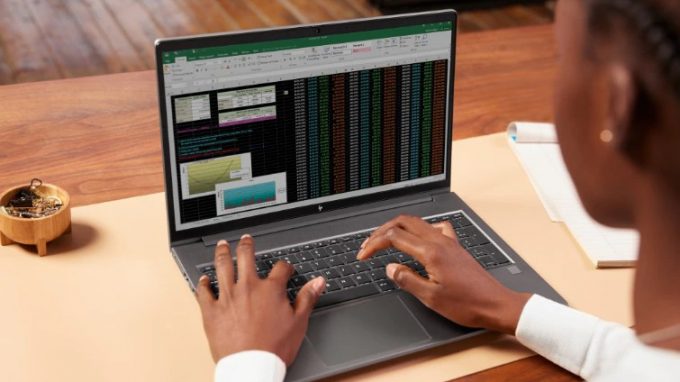 Little by little, we are assembling the Avengers of mobile workstation computing. And soon, we will be able to determine, which one is the best “affordable” device in this segment. We put affordable in quotes because this term is a little far stretched. Ultimately, it is true if you are into the workstation world, but in regular people’s language, it costs quite a fortune.
Little by little, we are assembling the Avengers of mobile workstation computing. And soon, we will be able to determine, which one is the best “affordable” device in this segment. We put affordable in quotes because this term is a little far stretched. Ultimately, it is true if you are into the workstation world, but in regular people’s language, it costs quite a fortune.
Nevertheless, the HP ZBook Power G8 is a relatively thin and light 15-inch laptop, that packs quite the punch with its Tiger Lake processors, the most powerful of which is the Core i9-11950H. Also, if you need a dedicated graphics card, there are three options, all coming from NVIDIA. In order from worst to best, they are the Quadro T600, Quadro T1200, and Quadro RTX A2000. Indeed, we doubt you are going to get working with huge files, since the graphics memory here is “only” 4GB, but it is good to know, you get all of the certificates needed to work effortlessly with professional software.
So, we are going to discuss more of the specs later on in the review, but before we start we want to set some competition for this device. Two of the devices we’re going to compare the ZBook Power G8 against are the Dell Precision 15 3561, and the Lenovo ThinkPad P15v Gen 2. Neither of them was perfect, with each of them having their own setbacks, as well as one common – poor cooling. Ultimately, we feel that this can be a deciding factor. Without further ado, let’s take the laptop out of the package, and discuss its design and features.
You can check the prices and configurations in our Specs System: https://laptopmedia.com/series/hp-zbook-power-g8/
Contents
Specs Sheet
- HDD/SSD
- up to 2000GB SSD + up to 1000GB HDD
- M.2 Slot
- 1x 2280 PCIe x4 4.0 + 1x 2280 PCIe x4 See photo
- RAM
- up to 64GB
- OS
- Windows 11 Pro, Windows 10 Pro, Windows 10 Home
- Battery
- 83Wh, 83Wh, 6-cell
- Body material
- Plastic / Polycarbonate, Aluminum
- Dimensions
- 359.4 x 233.9 x 22.8 mm (14.15" x 9.21" x 0.90")
- Weight
- 1.89 kg (4.2 lbs)
- Ports and connectivity
- 3x USB Type-A
- 1x USB Type-C
- Thunderbolt 4
- HDMI
- 2.0
- Ethernet LAN
- 10, 100, 1000 Mbit/s
- Wi-Fi
- 802.11ax
- Bluetooth
- 5.0
- Audio jack
- 3.5mm Combo Jack
- Smart Card Reader
- Features
- Fingerprint reader
- optional
- Web camera
- HD
- Backlit keyboard
- Microphone
- Speakers
- 2x Stereo Speakers
- Optical drive
- Security Lock slot
All HP ZBook Power G8 configurations
What’s in the box?
Inside the package, we found a 150W power adapter, some paper manuals, and the ZBook Power G8 itself.
Design and construction
This laptop’s construction is mainly executed out of aluminum. It has a great build quality with almost zero flex from the chassis and very little one from the lid. This is great, considering the modest dimension values of 22.8mm of thickness, and 1.90 kg of weight.
In addition to that, the lid opens easily with a single hand. The hinges around the matte panel are pretty thin, with the top one housing an HD Web camera with an optional IR face recognition scanner.
Then, there is the base cover, which is also made out of aluminum and is very stiff, resulting in almost no keyboard deck bend. The keyboard here has decent key travel, clicky, yet quiet feedback, and features a backlight and a NumberPad section. Of course, it doesn’t feel as comfortable as that of the ThinkPad P15v Gen 2, but it is more than good for the job. And furthermore – it is spill-resistant.
Unfortunately for some, there is no tracking stick in the middle of the keyboard, but honestly, we were never fans of that. On the other hand, there is the touchpad, which is very accurate and has a snappy response. Here, the clicking mechanism was a bit loud but other than that, the unit is great.
By the way, this laptop’s speakers are firing towards the user, and are hidden beneath a grill above the keyboard. Well, they take approximately 20% of the area of the grill, so the rest of it is there for aesthetics.
This means that if you turn the laptop upside-down, you will only see the cool air vents. Hot air, respectively, is blown away through two grills in between the base, and the lid.
Ports
On the left side of the notebook, you will find a security lock slot, an RJ-45 connector, a USB Type-A 3.2 (Gen. 1) port, an HDMI connector, and an optional Smart Card reader. Then, on the right, you have the power plug, a Thunderbolt 4 connector, two USB Type-A 3.2 (Gen. 1) ports, and an audio jack.
Disassembly, upgrade options and maintenance
This notebook’s bottom panel is held in place by 5 Phillips-head screws, three of which are captive. After you undo them, pry the bottom panel with a plastic tool, and remove it from the chassis.
The battery capacity here is 83Wh.
It is advisable that you unplug the battery before you change any parts of the device. In terms of memory, there are two SODIMM slots, which fit up to 64GB of RAM in total. As for the storage, there are two M.2 slots. They can be configured to run at RAID mode, and one of them supports PCIe Gen 4 drives.
Cooling-wise, you get two heat pipes, cooling the CPU and the GPU. Additionally, there is another heat pipe, that manages the temperature of both the VRMs and the graphics memory.
Display quality
HP ZBook Power G8 has an IPS panel, model number AUO AUOA08B. Its diagonal is 15.6″ (39.62 cm), and the resolution – 1920 х 1080 pixels. The screen ratio is 16:9, and we are looking at a pixel density of – 142 ppi, and a pitch of 0.18 х 0.18 mm. The screen turns into Retina when viewed at distance equal to or greater than 60cm (24″) (from this distance one’s eye stops differentiating the separate pixels, and it is normal for looking at a laptop).
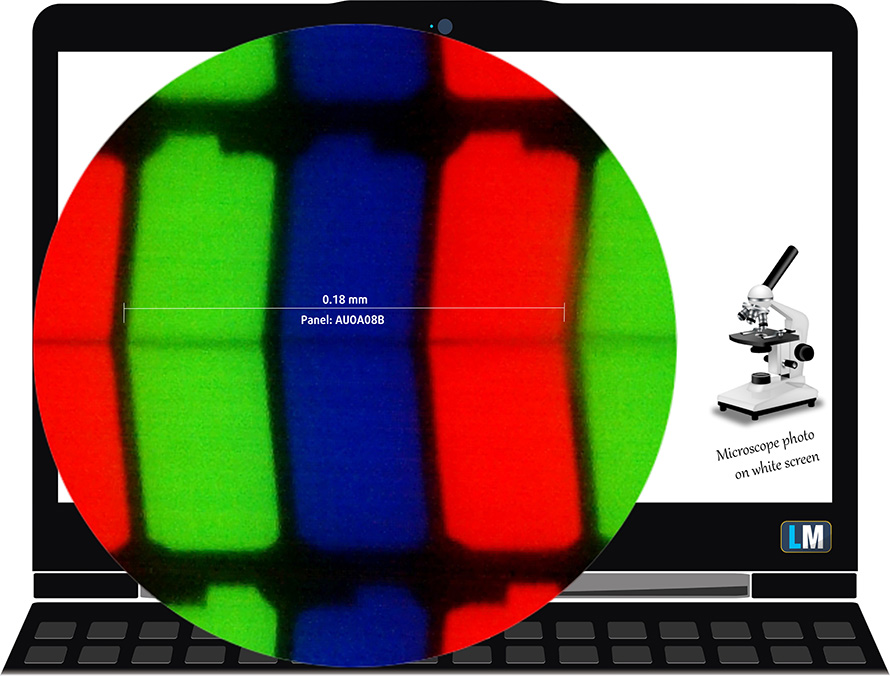
It has comfortable viewing angles. We offer images at 45° to evaluate image quality.

Also, a video with locked focus and exposure.
The measured maximum brightness of 390 nits in the middle of the screen and also 382 nits as an average for the whole area, with a maximum deviation of only 5%. The Correlated Color Temperature on a white screen is 6650K – slightly colder and almost matching the optimal for the sRGB standard of 6500K.
In the illustration below you can see how the display performs from a uniformity perspective. In other words, the leakage of light from the light source.
Values of dE2000 over 4.0 should not occur, and this parameter is one of the first you should check if you intend to use the laptop for color-sensitive work. The contrast ratio is very good – 1650:1.
To make sure we are on the same page, we would like to give you a little introduction to the sRGB color gamut and the Adobe RGB. To start, there’s the CIE 1976 Uniform Chromaticity Diagram that represents the visible specter of colors by the human eye, giving you a better perception of the color gamut coverage and the color accuracy.
Inside the black triangle, you will see the standard color gamut (sRGB) that is being used by millions of people on HDTV and on the web. As for the Adobe RGB, this is used in professional cameras, monitors, etc for printing. Basically, colors inside the black triangle are used by everyone and this is the essential part of the color quality and color accuracy of a mainstream notebook.
Still, we’ve included other color spaces like the famous DCI-P3 standard used by movie studios, as well as the digital UHD Rec.2020 standard. Rec.2020, however, is still a thing of the future and it’s difficult for today’s displays to cover that well. We’ve also included the so-called Michael Pointer gamut, or Pointer’s gamut, which represents the colors that naturally occur around us every day.
The yellow dotted line shows HP ZBook Power G8’s color gamut coverage.
Its display covers 99% of the sRGB/ITU-R BT.709 (web/HDTV standard) in CIE1976.
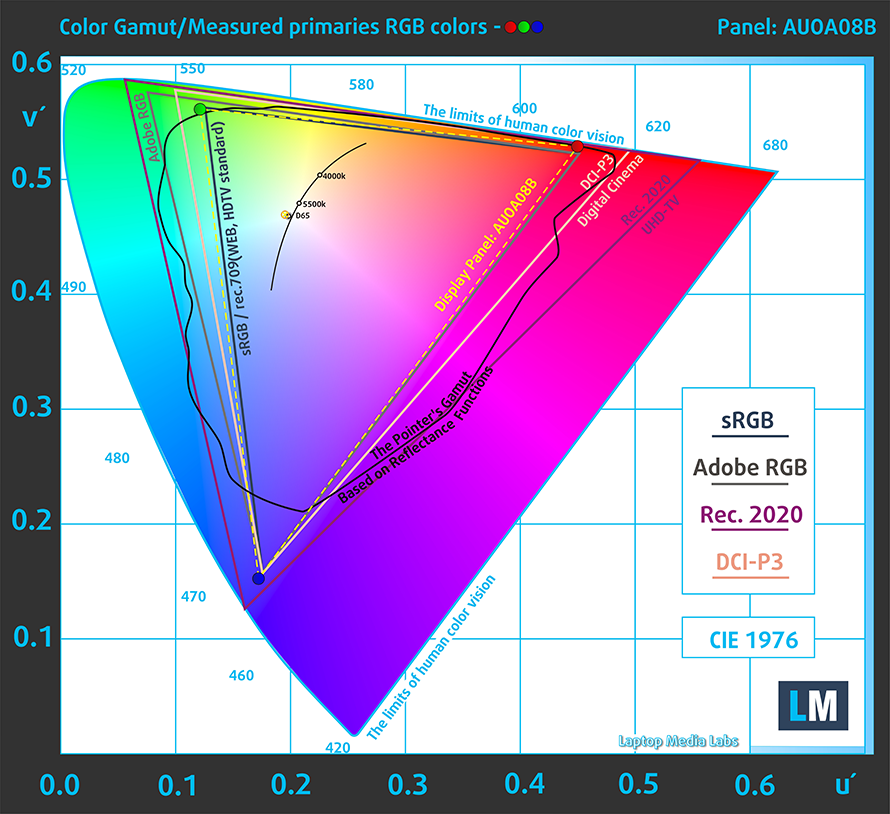
Our “Design and Gaming” profile delivers optimal color temperature (6500K) at 140 cd/m2 luminance and sRGB gamma mode.
We tested the accuracy of the display with 24 commonly used colors like light and dark human skin, blue sky, green grass, orange, etc. You can check out the results at factory condition and also, with the “Design and Gaming” profile.
Below you can compare the scores of HP ZBook Power G8 with the default settings (left), and with the “Gaming and Web design” profile (right).
The next figure shows how well the display is able to reproduce really dark parts of an image, which is essential when watching movies or playing games in low ambient light.
The left side of the image represents the display with stock settings, while the right one is with the “Gaming and Web Design” profile activated. On the horizontal axis, you will find the grayscale, and on the vertical axis – the luminance of the display. On the two graphs below you can easily check for yourself how your display handles the darkest nuances but keep in mind that this also depends on the settings of your current display, the calibration, the viewing angle, and the surrounding light conditions.
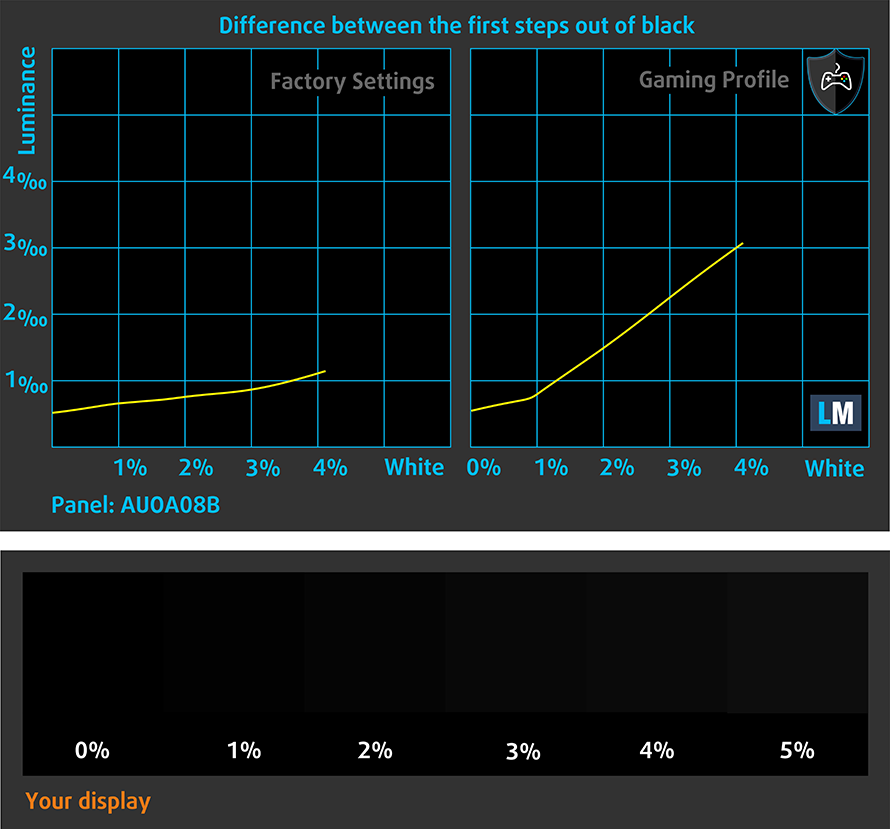
Response time (Gaming capabilities)
We test the reaction time of the pixels with the usual “black-to-white” and “white-to-black” method from 10% to 90% and vice versa.
We recorded Fall Time + Rise Time = 29 ms.
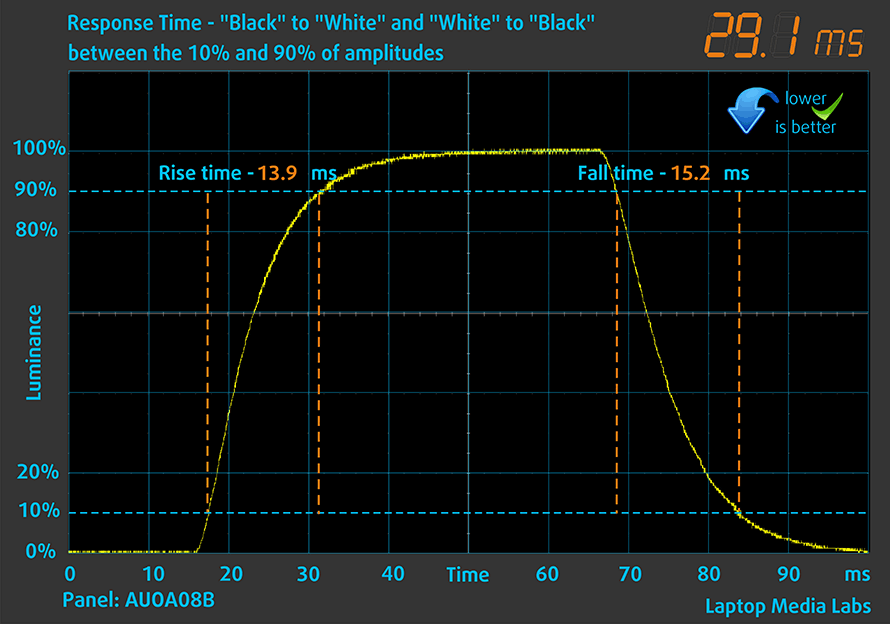
After that, we test the reaction time of the pixels with the usual “Gray-to-Gray” method from 50% White to 80% White and vice versa between 10% and 90% of the amplitude.
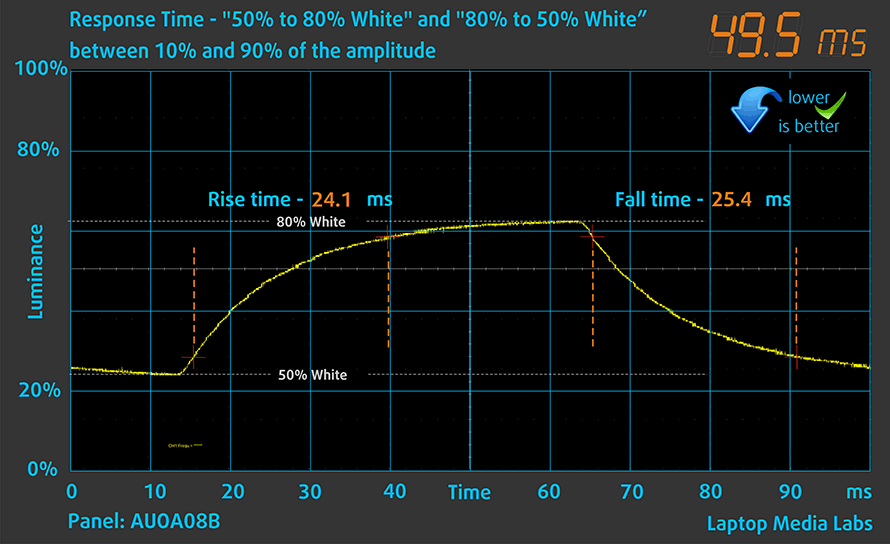
PWM (Screen flickering)
Pulse-width modulation (PWM) is an easy way to control monitor brightness. When you lower the brightness, the light intensity of the backlight is not lowered, but instead turned off and on by the electronics with a frequency indistinguishable to the human eye. In these light impulses, the light/no-light time ratio varies, while brightness remains unchanged, which is harmful to your eyes. You can read more about that in our dedicated article on PWM.
HP ZBook Power G8’s screen doesn’t flicker at any brightness level. Thankfully, this enables you to work for extended periods of time, without the risk of further damaging your eyes and brain.
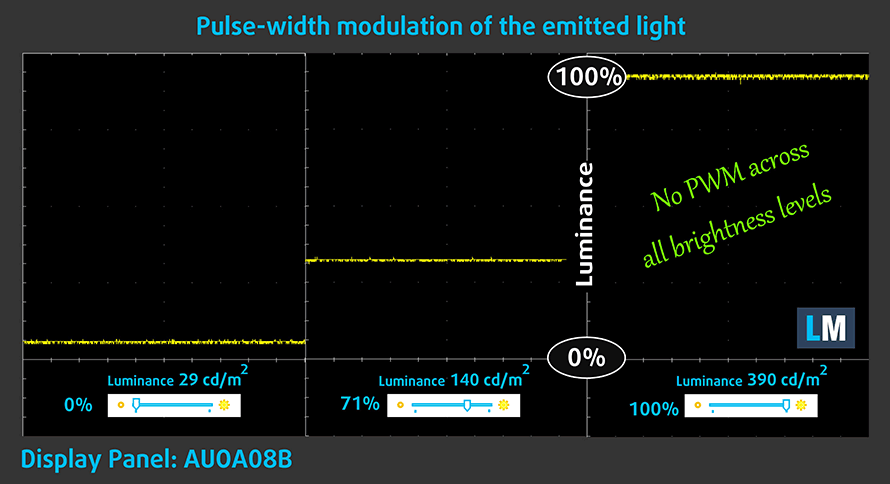
Blue light emissions
Installing our Health-Guard profile not only eliminates PWM but also reduces the harmful Blue Light emissions while keeping the colors of the screen perceptually accurate. If you’re not familiar with the Blue light, the TL;DR version is – emissions that negatively affect your eyes, skin, and your whole body. You can find more information about that in our dedicated article on Blue Light.
Buy our profiles
Since our profiles are tailored for each individual display model, this article and its respective profile package are meant for HP ZBook Power G8 configurations with 15.6″ FHD IPS AUO AUOA08B.
*Should you have problems with downloading the purchased file, try using a different browser to open the link you’ll receive via e-mail. If the download target is a .php file instead of an archive, change the file extension to .zip or contact us at [email protected].
Read more about the profiles HERE.
In addition to receiving efficient and health-friendly profiles, by buying LaptopMedia's products you also support the development of our labs, where we test devices in order to produce the most objective reviews possible.

Office Work
Office Work should be used mostly by users who spend most of the time looking at pieces of text, tables or just surfing. This profile aims to deliver better distinctness and clarity by keeping a flat gamma curve (2.20), native color temperature and perceptually accurate colors.

Design and Gaming
This profile is aimed at designers who work with colors professionally, and for games and movies as well. Design and Gaming takes display panels to their limits, making them as accurate as possible in the sRGB IEC61966-2-1 standard for Web and HDTV, at white point D65.

Health-Guard
Health-Guard eliminates the harmful Pulse-Width Modulation (PWM) and reduces the negative Blue Light which affects our eyes and body. Since it’s custom tailored for every panel, it manages to keep the colors perceptually accurate. Health-Guard simulates paper so the pressure on the eyes is greatly reduced.
Get all 3 profiles with 33% discount
Sound
HP ZBook Power G8’s speakers produce a sound of decent quality. However, there are some deviations across the entire frequency range.

Drivers
All of the drivers and utilities for this notebook can be found here: https://support.hp.com/us-en/drivers/selfservice/hp-zbook-power-15.6-inch-g8-mobile-workstation-pc/2100648425
Battery
Now, we conduct the battery tests with Windows Better performance setting turned on, screen brightness adjusted to 120 nits, and all other programs turned off except for the one we are testing the notebook with. This laptop’s 83Wh battery pack lasted for 8 hours and 28 minutes of Web browsing, and 13 hours and 31 minutes of video playback.
In order to simulate real-life conditions, we used our own script for automatic web browsing through over 70 websites.
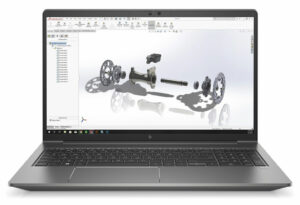
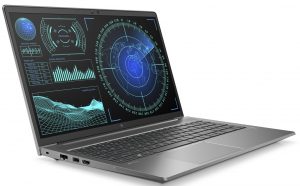
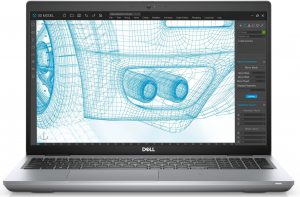
For every test like this, we use the same video in HD.



CPU options
This device can be purchased with the Core i5-11400H, Core i7-11800H, and Core i9-11900H, as well as their vPro versions – respectively, Core i5-11500H, Core i7-11850H, and Core i9-11950H.
Results are from the Cinebench R23 CPU test (the higher the score, the better)
Results are from our Photoshop benchmark test (the lower the score, the better)
HP ZBook Power G8 CPU variants
Here you can see an approximate comparison between the CPUs that can be found in the HP ZBook Power G8 models on the market. This way you can decide for yourself which HP ZBook Power G8 model is the best bang for your buck.
Note: The chart shows the cheapest different CPU configurations so you should check what the other specifications of these laptops are by clicking on the laptop’s name / CPU.
Results are from the Cinebench R23 CPU test (the higher the score, the better)
Results are from our Photoshop benchmark test (the lower the score, the better)
GPU options
Graphics-wise, up for grabs are configurations with the NVIDIA Quadro T600, Quadro T1200, and Quadro RTX A2000. All of them come with 4GB of GDDR6 graphics memory, and while the former two come with the very popular TU117 chip, the RTX A2000 is fitted with the brand new Ampere architecture, which makes it in the ballpark of RTX 3050 and RTX 3050 Ti in terms of performance.
Results are from the 3DMark: Time Spy (Graphics) benchmark (higher the score, the better)
Results are from the 3DMark: Fire Strike (Graphics) benchmark (higher the score, the better)
Results are from the Unigine Superposition benchmark (higher the score, the better)
HP ZBook Power G8 GPU variants
Here you can see an approximate comparison between the GPUs that can be found in the HP ZBook Power G8 models on the market. This way you can decide for yourself which HP ZBook Power G8 model is the best bang for your buck.
Note: The chart shows the cheapest different GPU configurations so you should check what the other specifications of these laptops are by clicking on the laptop’s name / GPU.
Results are from the 3DMark: Time Spy (Graphics) benchmark (higher the score, the better)
Results are from the 3DMark: Fire Strike (Graphics) benchmark (higher the score, the better)
Results are from the 3DMark: Wild Life (Graphics) benchmark (higher the score, the better)
Results are from the Unigine Superposition benchmark (higher the score, the better)
Gaming tests

| Far Cry 5 | Full HD, Normal (Check settings) | Full HD, High (Check settings) | Full HD, Ultra (Check settings) |
|---|---|---|---|
| Average fps | 54 fps | 49 fps | 45 fps |

| Rise of the Tomb Raider (2016) | Full HD, Lowest (Check settings) | Full HD, Medium (Check settings) | Full HD, Very High (Check settings) |
|---|---|---|---|
| Average fps | 98 fps | 68 fps | 34 fps |

| Shadow of the Tomb Raider (2018) | Full HD, Lowest (Check settings) | Full HD, Medium (Check settings) | Full HD, High (Check settings) |
|---|---|---|---|
| Average fps | 80 fps | 47 fps | 40 fps |

| Tom Clancy’s Ghost Recon Wildlands | Full HD, Medium (Check settings) | Full HD, High (Check settings) | Full HD, Very High (Check settings) |
|---|---|---|---|
| Average fps | 54 fps | 46 fps | 41 fps |
Temperatures and comfort
Max CPU load
In this test we use 100% on the CPU cores, monitoring their frequencies and chip temperature. The first column shows a computer’s reaction to a short load (2-10 seconds), the second column simulates a serious task (between 15 and 30 seconds), and the third column is a good indicator of how good the laptop is for long loads such as video rendering.
Average core frequency (base frequency + X); CPU temp.
| Intel Core i7-11800H (45W TDP) | 0:02 – 0:10 sec | 0:15 – 0:30 sec | 10:00 – 15:00 min | Max Fans |
|---|---|---|---|---|
| HP ZBook Power G8 | 3.47 GHz (B+51%) @ 97°C @ 79W | 3.20 GHz (B+39%) @ 98°C @ 67W | 2.95 GHz (B+28%) @ 98°C @ 57W | – |
| Acer Predator Helios 300 (PH317-55) | 3.67 GHz (B+60%) @ 90°C @ 103W | 3.66 GHz (B+59%) @ 99°C @ 103W | 3.40 GHz (B+48%) @ 99°C @ 84W | – |
| ASUS ROG Zephyrus M16 GU603 | 3.87 GHz (B+68%) @ 95°C @ 106W | 3.90 GHz (B+70%) @ 95°C @ 109W | 3.58 GHz (B+56%) @ 86°C @ 80W | – |
| MSI Creator Z16 (A11Ux) | 3.12 GHz (B+36%) @ 96°C @ 68W | 3.03 GHz (B+32%) @ 95°C @ 62W | 2.76 GHz (B+20%) @ 95°C @ 53W | 2.90 GHz (B+26%) @ 95°C @ 59W |
| MSI GE76 Raider (2021) | 3.22 GHz (B+40%) @ 95°C @ 67W | 3.11 GHz (B+35%) @ 94°C @ 62W | 3.14 GHz (B+37%) @ 94°C @ 61W | 3.26 GHz (B+42%) @ 94°C @ 64W |
| ASUS TUF F15 (FX506, 2021) (Turbo Mode) | 3.98 GHz (B+73%) @ 86°C @ 102W | 3.88 GHz (B+69%) @ 95°C @ 100W | 3.44 GHz (B+50%) @ 87°C @ 77W | – |
| MSI Pulse GL76 | 3.16 GHz (B+37%) @ 95°C @ 65W | 3.00 GHz (B+30%) @ 95°C @ 59W | 2.87 GHz (B+25%) @ 95°C @ 55W | – |
| MSI Pulse GL66 | 2.94 GHz (B+28%) @ 94°C @ 58W | 2.76 GHz (B+20%) @ 94°C @ 52W | 2.77 GHz (B+20%) @ 94°C @ 52W | – |
Okay, the ZBook Power G8 is not terrible in terms of cooling its CPU, but it can definitely do better in our opinion.
Real-life gaming
| NVIDIA Quadro T600 | GPU frequency/ Core temp (after 2 min) | GPU frequency/ Core temp (after 30 min) |
|---|---|---|
| HP ZBook Power G8 | 1432 MHz @ 58°C | 1432 MHz @ 57°C |
| Lenovo ThinkPad P15v Gen 2 | 1311 MHz @ 77°C | 1300 MHz @ 80°C |
| Dell Precision 15 3561 | 1333 MHz @ 71°C | 1338 MHz @ 70°C |
Now, this is what we wanted to see. During combined load such as gaming, this laptop runs extremely cool. Its GPU barely bothers the cooling system, and as result, it works at 100 MHz higher and 13°C lower than the Precision 15 3561, and 23°C lower than the ThinkPad P15v Gen 2.
Comfort during combined load
In addition to that, the laptop is not that loud either. The presence of a second fan reduces the need for high RPM, which results in a decrease in the noise levels.
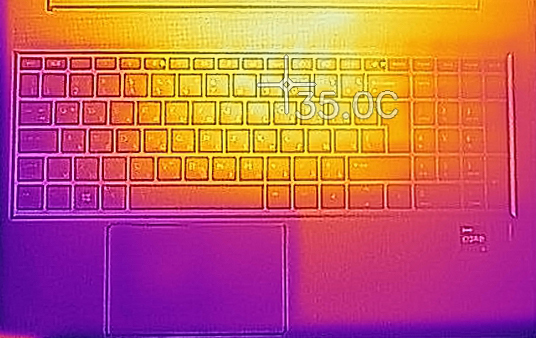
Verdict
 Okay guys, today we have a huge dilemma waiting to be solved. Should you buy the ZBook Power G8, Dell Precision 15 3561, or Lenovo ThinkPad P15v Gen 2. Ultimately, they are all mobile workstations, which claim to be on the more affordable section of the market. Well, starting with the design, the HP we had here today is the only device of the three to come with a metal design. Additionally, the build quality is on point, and we observed high structural integrity.
Okay guys, today we have a huge dilemma waiting to be solved. Should you buy the ZBook Power G8, Dell Precision 15 3561, or Lenovo ThinkPad P15v Gen 2. Ultimately, they are all mobile workstations, which claim to be on the more affordable section of the market. Well, starting with the design, the HP we had here today is the only device of the three to come with a metal design. Additionally, the build quality is on point, and we observed high structural integrity.
Additionally, one of the two M.2 PCIe x4 slots supports Gen 4 drives, and both M.2 slots can work in RAID mode. Respectively, the I/O seemed pretty standard, although the lack of an SD card reader was a bit unsettling. Nevertheless, you get Thunderbolt 4 support. Other features include an optional IR face recognition scanner, a fingerprint reader, and a privacy shutter on the HD Web camera.
Thankfully, the keyboard is comfortable for typing, has a backlight, and is spill-resistant. As for the battery, it lasted for 8 hours and 28 minutes of Web browsing, and 13 hours and 31 minutes of video playback.
HP ZBook Power G8’s IPS panel (AUO AUOA08B) has a Full HD resolution, comfortable viewing angles, relatively high maximum brightness, and a very good aspect ratio. Its backlight doesn’t use PWM for brightness adjustment, and it covers 99% of the sRGB color gamut. Additionally, our Gaming and Web design profile greatly improves the color accuracy to an Average dE of 0.8. This makes it appropriate for professional-grade work.
Of course, another really important feature here is the performance. Although HP has borrowed the cooling design from last year’s model, it happens to deal well with the graphics card. Still, the fact that it utilizes two fans makes it superior to the Precision and ThinkPad we mentioned earlier. This can be seen in the GPU temperature tests.
So, if you manage to find a good price for this laptop, we would advise you to get it. Of course, there are more powerful devices, but this one weighs only 1.90 kg and has pretty much everything you will need (with some exceptions).
You can check the prices and configurations in our Specs System: https://laptopmedia.com/series/hp-zbook-power-g8/
Pros
- Great upgradability + PCIe Gen 4 and RAID support
- Lack of PWM (AUO AUOA08B
- 99% sRGB coverage and accurate color representation with our Gaming and Web design profile (AUO AUOA08Bf)
- Good input devices
- Optional IR face recognition, fingerprint reader
- Thunderbolt 4
- Metal chassis with a good build quality
Cons
- No SD card reader
- Its CPU could make use of a better cooling policy
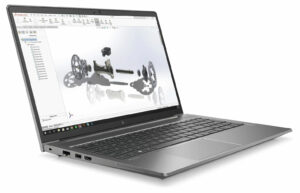
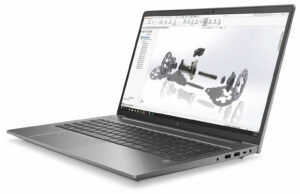
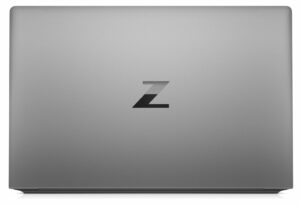


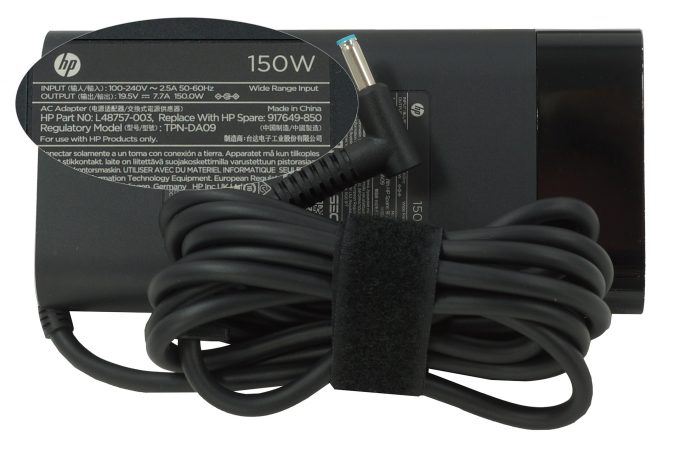
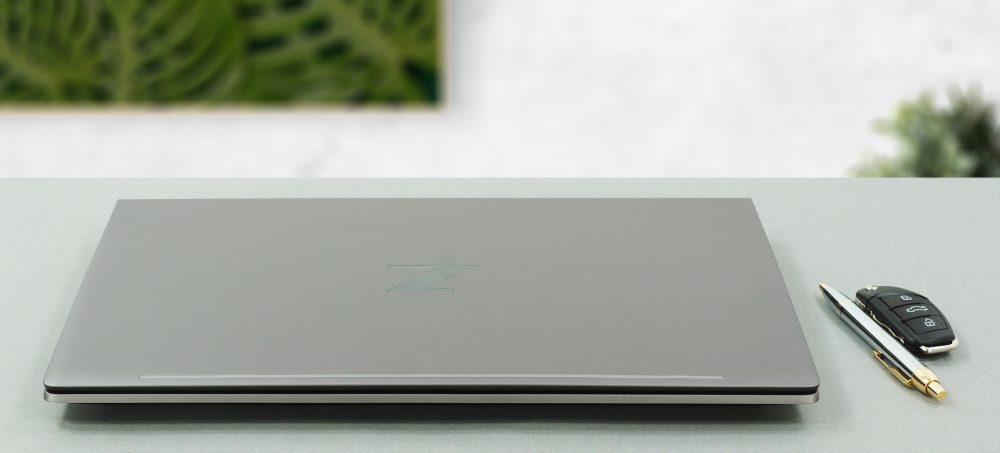
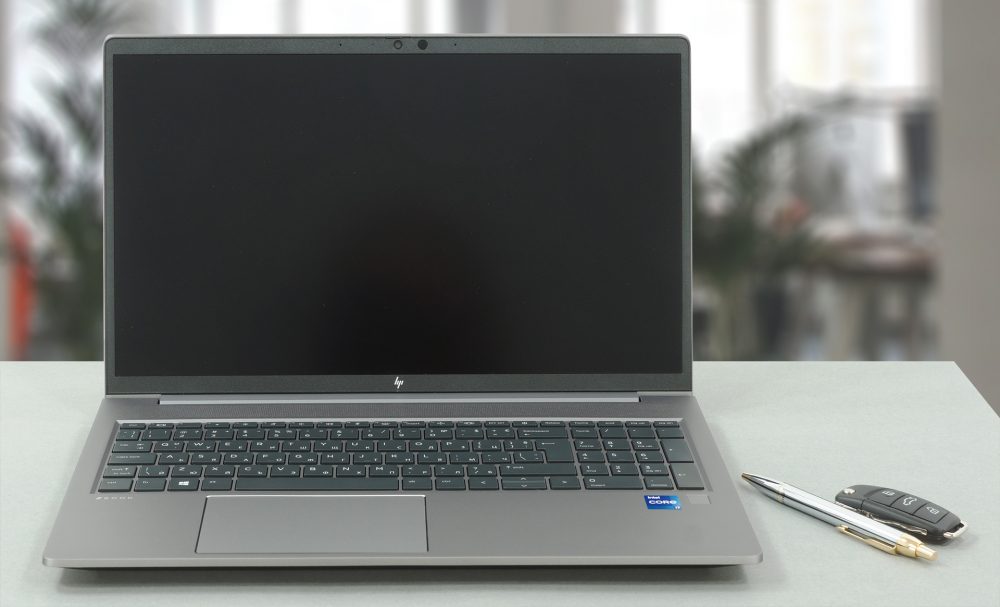
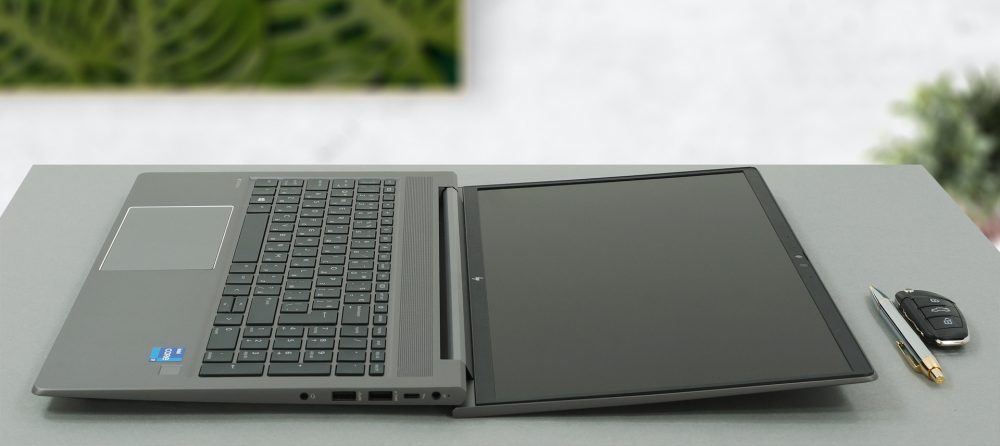
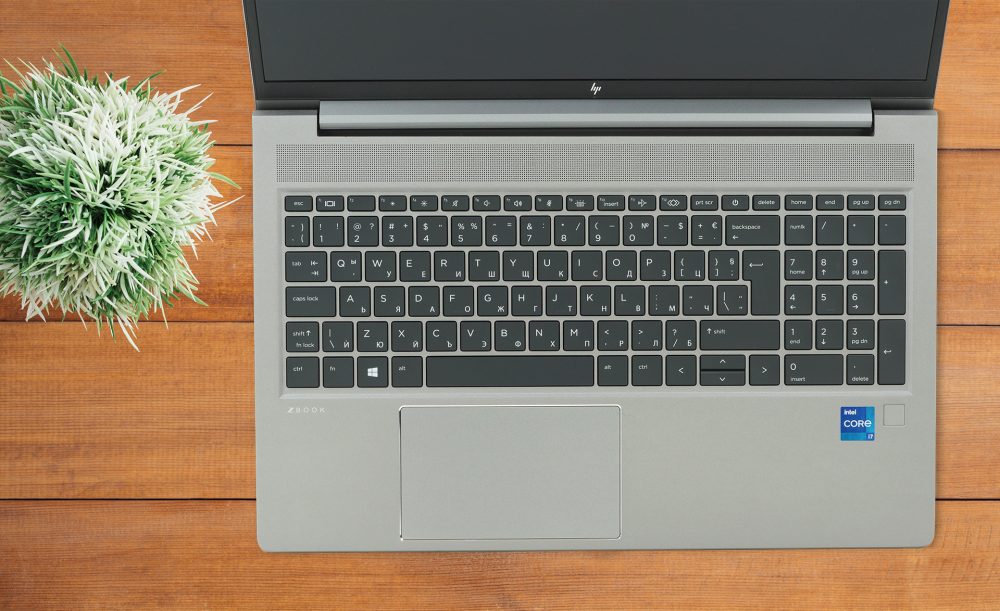
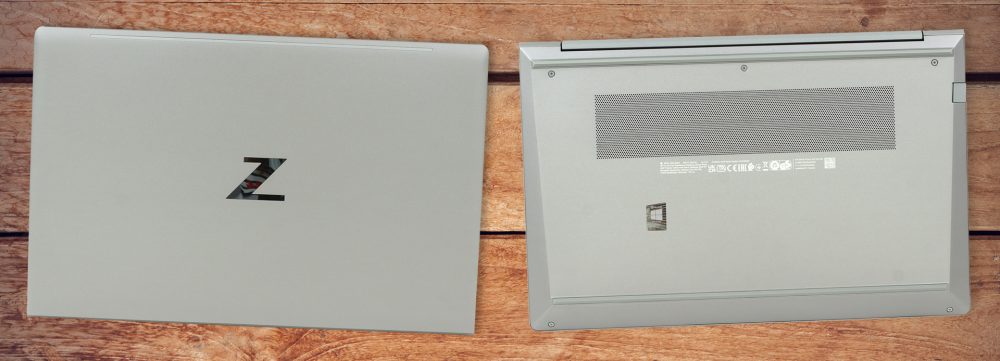


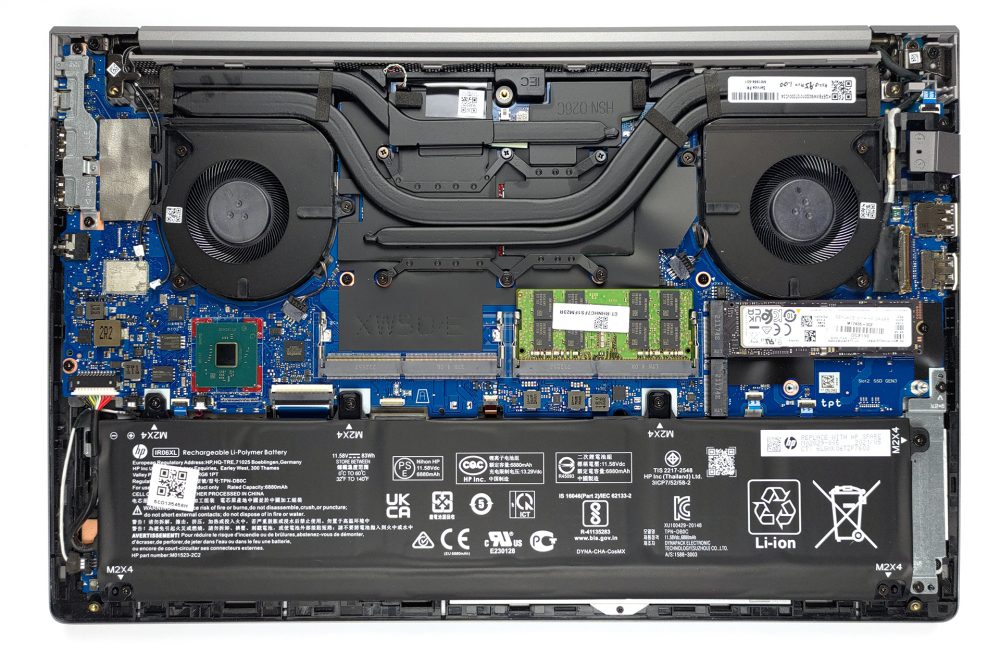

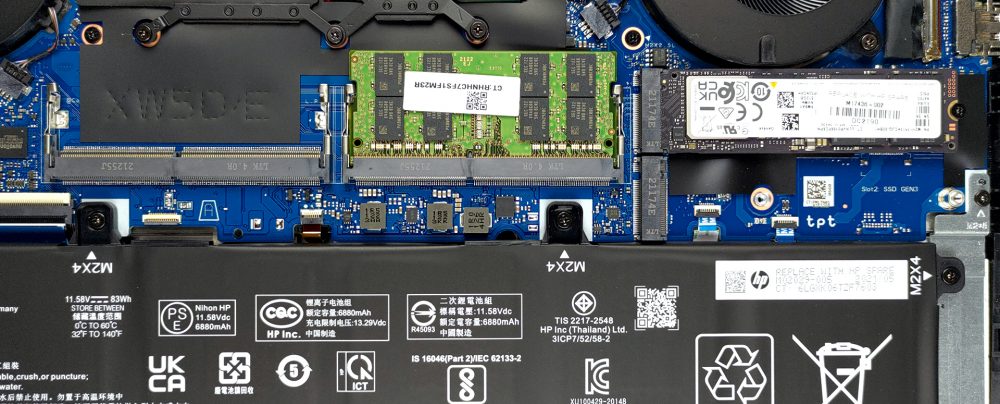



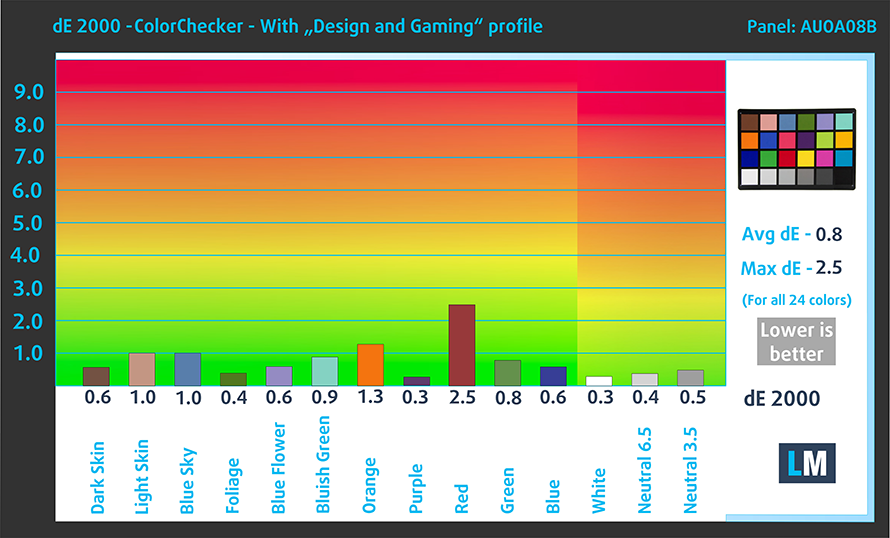

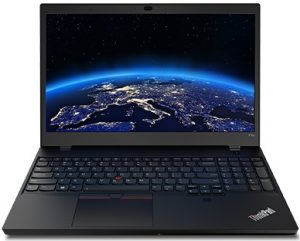









Wow such a great article, you get in depth of every feature, specification and aspects of this laptop
I Loved to read your review.
Keep Going